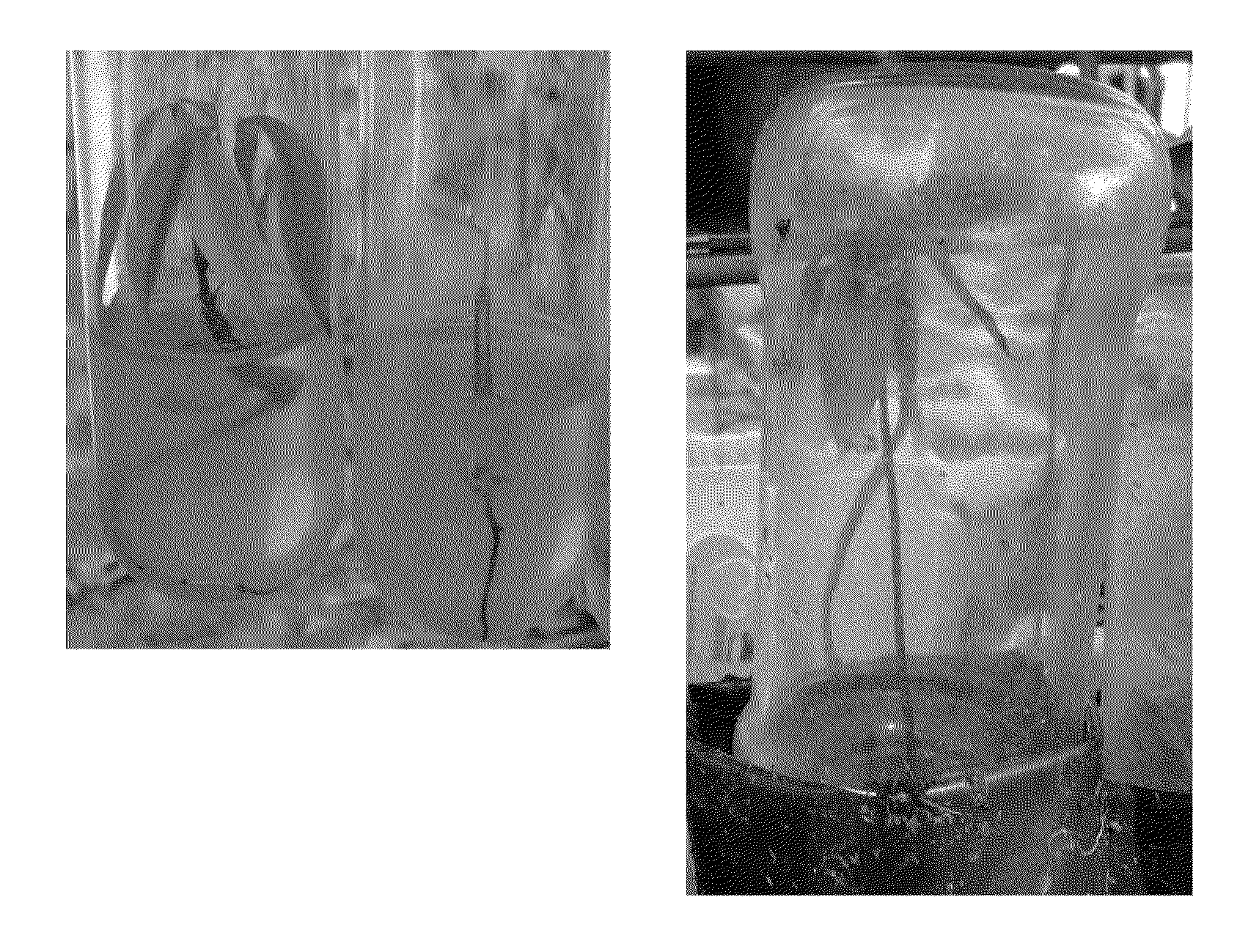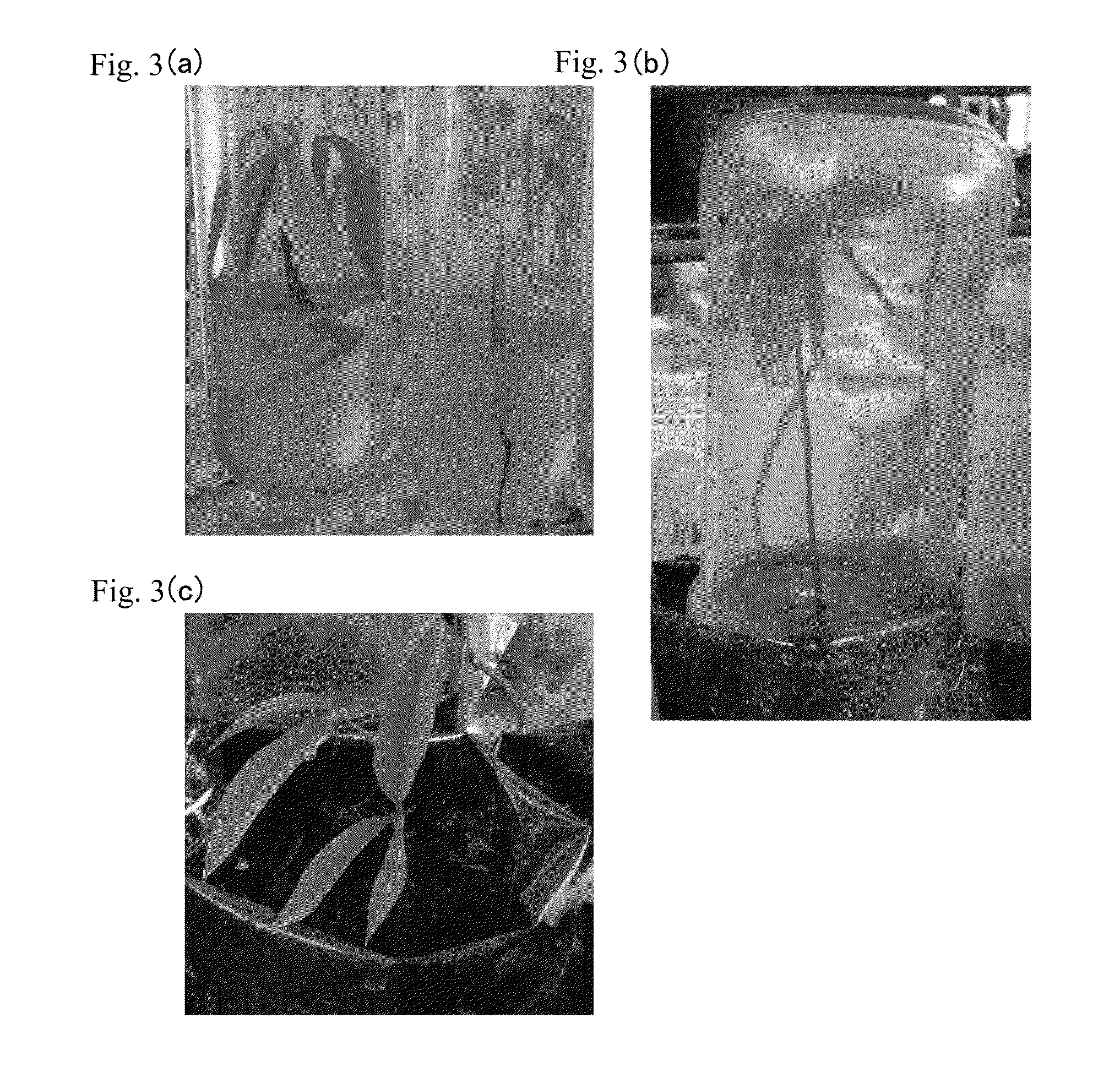Method of regenerating rubber tree, method of propagating rubber tree, method of inducing shoot, method of elongating shoot, method of rooting shoot, and method of acclimatizing young plant
a technology of rubber tree and regenerative method, which is applied in the field of regenerating rubber tree, can solve the problems of reducing the number of clone seedlings, affecting the growth rate of clones, and the limited period during which natural rubber can be extracted from mature trees, etc., and achieves the effect of stably regenerating rubber tree, acquiring large numbers of clones, and propagating clones
- Summary
- Abstract
- Description
- Claims
- Application Information
AI Technical Summary
Benefits of technology
Problems solved by technology
Method used
Image
Examples
examples
[0159]The present invention will be described in detail with reference to Examples, but the present invention is not limited to the examples.
[0160]The chemicals used in Examples are listed below.
BA: Benzyladenine
KI: Kinetin
[0161]NAA: 1-naphthaleneacetic acid
IBA: Indole-3-butyric acid
Silver Nitrate: Silver nitrate made by Merck
Coconut Water: Commercially available coconut palm fruit
Gellant: Agar (powder) made by Fluka
Disinfectant: Pyrad-Povidone (trade name) (povidone-iodine solution) made by The United Drug
H. brasiliensis: Hevea brasiliensis that naturally grew within Prince of Songkla University
examples 1 to 18
, Comparative Examples 1 to 6
Induction Step
[0162]A tissue including a node, axillary bud, or apical bud was collected from a mature tree or a plantlet of H. brasiliensis. Moreover, a tissue including a node, axillary bud, or apical bud was collected from a seedling (aseptic seedling) obtained by aseptically germinating and culturing a seed of H. brasiliensis in vitro.
[0163]Next, the tissue including a node, axillary bud, or apical bud collected from the mature tree or plantlet was washed with running water and further washed with 70 mass % ethanol, followed by sterilization with aqueous sodium hypochlorite diluted to about 5 to 10 volume %, and then washing with sterilized water.
[0164]Next, the sterilized tissue or the tissue derived from the aseptic seedling was inserted into an induction medium (solid medium) and cultured (induction step). The induction medium was prepared in such a manner that a plant hormone, silver nitrate, sucrose, activated carbon, and coconut water at predet...
examples 19 to 27
, Comparative Examples 7 to 15
Elongation Step
[0171]The shoots induced by culture in Examples 1 to 9 and then grown by subculture were each cultured in an elongation medium (elongation step). The elongation medium had a two-layered structure and the two layers were based on MS medium (disclosed on pages 20 to 36 of Shokubutsu Saibo Kogaku Nyumon (Introduction to Plant Cell Engineering), Japan Scientific Societies Press). The lower layer medium was prepared in such a manner that a plant hormone, silver nitrate, sucrose, and activated carbon at predetermined concentrations shown in the Table 2 below were added to MS medium, the pH of the medium was adjusted to 5.7, and a gellant was added at 0.75 mass %, followed by autoclave sterilization (at 121° C. for 20 minutes) and then cooling in a clean bench. The upper layer medium was prepared in such a manner that a plant hormone at a predetermined concentration shown in the Table 2 below was added to ½ MS medium and the pH of the medium was...
PUM
| Property | Measurement | Unit |
|---|---|---|
| mass % | aaaaa | aaaaa |
| concentration | aaaaa | aaaaa |
| concentration | aaaaa | aaaaa |
Abstract
Description
Claims
Application Information
 Login to View More
Login to View More - R&D
- Intellectual Property
- Life Sciences
- Materials
- Tech Scout
- Unparalleled Data Quality
- Higher Quality Content
- 60% Fewer Hallucinations
Browse by: Latest US Patents, China's latest patents, Technical Efficacy Thesaurus, Application Domain, Technology Topic, Popular Technical Reports.
© 2025 PatSnap. All rights reserved.Legal|Privacy policy|Modern Slavery Act Transparency Statement|Sitemap|About US| Contact US: help@patsnap.com



